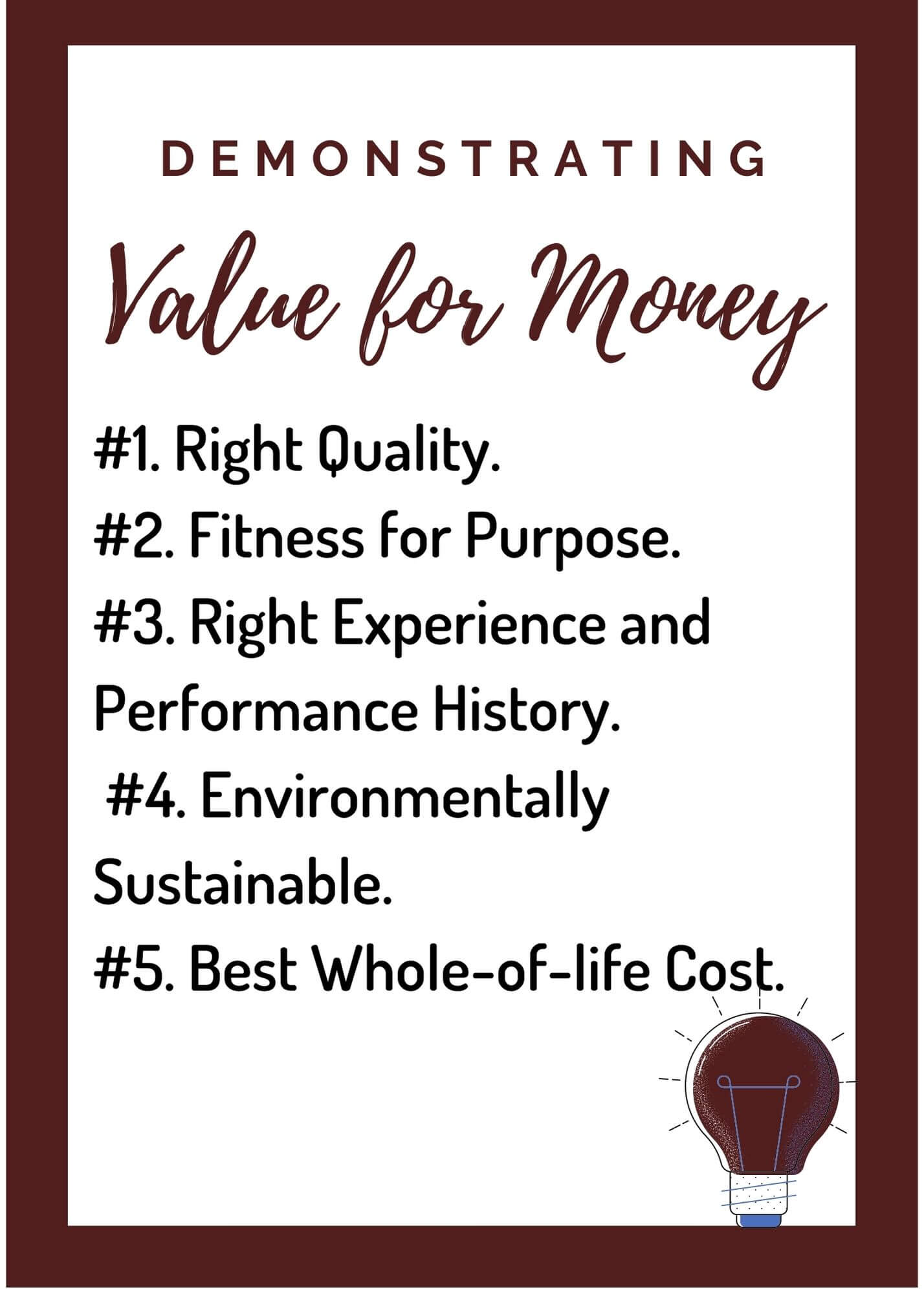Five Tips for Demonstrating Value for Money in Government Tenders
When selecting who to award a government tender to, government agencies and local governments must show how the contract awarded demonstrates the best Value for Money. It is not a matter of opinion or discretion.
No, in fact, the opposite.
The requirement for demonstrating value for money is a legislated requirement.
So, how do you sharpen your pencil to make sure that your tenders:
- deliver best value for money; and
- indeed stand out from the crowd?
Most government tenders are a crowded race.
Therefore, you really need to sharpen your pencil to make sure you deliver the best value for money to make your customer stand out from their competitors!
What is the requirement for best value for money?
Demonstrating value for money include the requirement to show clearly that your offered solution does provide the best option, including:
- The right quality;
- Is fit for purpose;
- Your organisation has the right experience and performance history.
- Your solution is environmentally sustainable; and
- Offers the best whole-of-life cost option.
It is not meant to be about price only, however your pricing must be competitive across the life of the solution offered.

Five Tips for Standing Out from your Competitors
As mentioned above, the government tendering space can be a really crowded place. Depending on the scope, you can be faced with competing with as many as thirty other tenders.
Therefore, you must not only look at ticking the boxes but really think about how your tenders can show best value. You must be clear on why you are tendering and what is the problem you are solving.
#1. Demonstrated experience in delivering the right quality and fitness-for purpose
Unfortunately in many instances, the scoping included in tenders are really poor. The specifications are vague and contradict itself.
Therefore, your response must clearly show that you meet the requirements in terms of quality, specification and fitness-for-purpose.
How do you do this?
Through examples of similar contracts awarded.
AND
By explaining how the application or solution will be specifically fit-for-purpose and the right quality for the tendering agency.
#2. Showcase a Track Record of Success
Tendering takes time.
Meeting the tick boxes can be painful.
Therefore, you really want to optimise your time and be able to scale for success.
How do you do this?
Your track record must demonstrate success – similar experience.
AND
A history of success in doing what you offered to do for others.
Set up your templates to explain just this.
BUT
Make sure it gives comfort and assurance to those evaluating your tender that your track record is the best of all of the tenders in front of them.
Hence take the time to provide case studies and similar examples. However, stay away from marketing and sales fluff.
#3. Deliver Sustainable Solutions
Sustainability is not limited to environmental sustainability as such.
Demonstrating sustainability includes areas such as:
- Environmental compliance and environmental friendly solutions;
- Indigenous procurement solutions,
- small business and buy local procurement;
- Ethical procurement solutions such as avoiding purchasing from organisations employing child labour and modern slavery practices.
Think about how you best showcase compliance, demonstrate why your offer delivers best sustainable outcomes at competitive pricing.
#4. Clear Best End-to-End Cost Solution
Whole of life cost can appear quite daunting to many businesses. However, it is in this area where you can often point out what your competitors hide when they so blatantly undercut the market in terms of the initial purchase price.
Hence, your offered solution and price must clearly demonstrate the best value for money across the life of the solution offered.
The best whole of life cost option is the best combination of the:
- Initial purchase price;
- Operating and maintenance costs;
- Transition Out / Closure Costs;
- Licencing Options;
- Cost of additional features required after initial purchase;
- Cost of Consumables;
- Sustainability impacts and costs (e.g. disposal/ recycling/repurposing)
- Decommissioning, remediation and/or disposal.
Value for Money Reference Guide
Quick Reference Guide on what is value for money, how best to demonstrate it and what is whole-of-life cost.
We know that many organisations focus on a really cheap (not competitive) price and then make heaps of money out of the government when upselling, variations and ad hoc pricing.
We prefer not to play this game but to focus on working with those agencies who do understand for themselves that whole of life cost means the best combination across the whole of life, not just the purchase price.
#5. Making the Customer Look Good
Many businesses work through the motions of getting tenders in and submitted.
It is furthermore true that many businesses are time poor and therefore have little time available, given the amount of red tape included in tenders.
However, you are not reading this post because you want to just go through the motions. I think it is because you are really interested in how you can make your tendering solutions stand out from the crowd.
Therefore, work on completing the red tape requirements, answering the questions and then take a few minutes to take one more step.
Google what is important for your potential customer. Then add a few lines throughout your tender response on how you understand what is important any why you will support the customer.
Let your tender submission speak for itself in three easy steps:
- You demonstrate capability and experience – similar and how you have done this successfully before;
- Show your understanding of the specific requirements of the tender – how you will make this tender work; and
- Then take time to clearly spell it out why you are solving the customer’s problem in a way that makes the customer look amazing.
Once you have done this a few times, you will have a set of excellent tender templates and you will be able to adjust your responses easily and with success.
Learn More:
We do run tendering workshops in Western Australia as part of the SBDC Business Local program. Contact us today and we will let you know of the next workshops.





